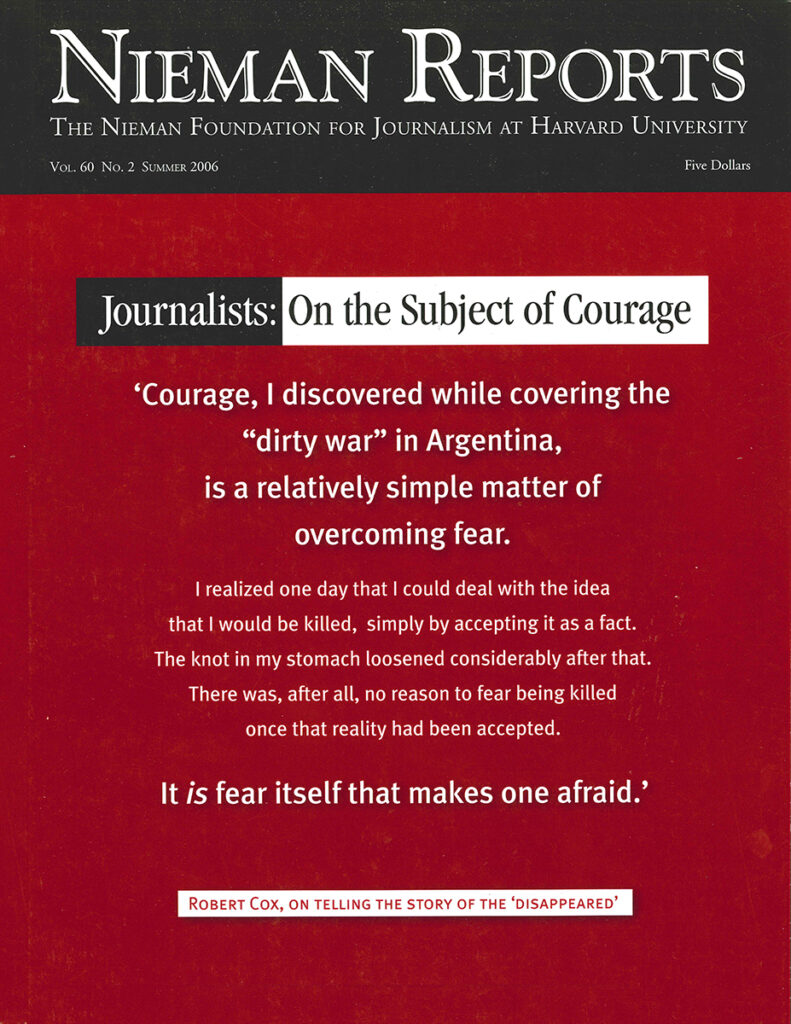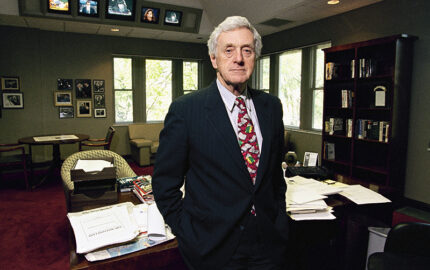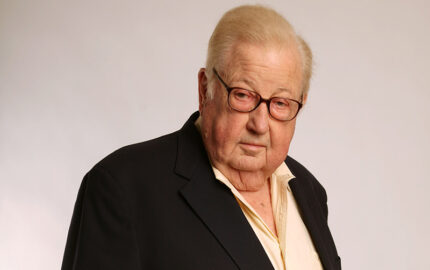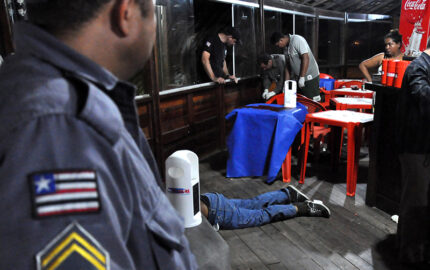
Journalists: On the Subject of Courage
Courage, as these journalists remind us, exposes itself in different guises. It can be found in the wisdom of understanding when danger finally has outweighed the risk. Or it can surface when threats to personal safety lurk but the lessons of training combine with inner strength to push fear aside and persevere. Courage can reside, too, in a journalist's isolation when editorial stands taken shake the foundation of friendship and sever long-held ties to one's community. In this issue, glimpses of such journalistic courage are offered.
Santiago Lyon, a 2004 Nieman Fellow, is the director of photography at The Associated Press, and therefore responsible for sending photographers into war zones, conflicts, civil unrest, and on other potentially dangerous assignments. At a Nieman Foundation conference held in October 2005, Lyon joined other journalists and trauma specialists to speak about how what journalists experience can affect their lives and health. The primary focus of his presentation was on the ethics of assigning journalists to cover war, crisis and disaster. An adapted version of what he said that day follows.
Being the director of photography at The Associated Press [AP] means I'm responsible for sending photographers into harm's way. Having been a photojournalist for 20 years, and having covered not a few such stories myself, I bring to my work a dual perspective: I've been on the frontlines and returned home, and now I am the one who must make decisions about sending others into places of chaos and danger.
Fresh-faced photographers, keen to go to war, come to my office almost every month wanting to go off to the next nasty conflict, disaster or famine. I do my best to put them off, telling them it's really not a very good idea. The keenest ones insist and sometimes they go. I know they will not likely be the same after they've seen what they will see, but they are adults. They make choices, and the world needs to see what their images might help them to see.
I also talk with the veteran journalists, repeat visitors to horrible places, who are resilient, strong and determined, but vulnerable, too. One of those veterans, a colleague and a friend, asked me in a private moment whether it is okay to stop going to these stories. "Of course," I told him. "Our health is all we have and that includes our mental health." Then I said to him, "When it gets to be too much, stop. Don't be shy. Be as decisive walking away as you were walking in." But I've watched, too, as some veterans, who haven't walked away, crumble. Sometimes I see their marriages fall apart. Their children become strangers to them. Knowing they're in pain, I reach out and try to offer assistance.
My responsibility to the brave individuals I assign is continuous and unwavering, before, during and after they've done their stories. It cannot be anything but that. Nobody is ever obliged to cover a dangerous or a difficult story. We only accept volunteers. But not just any volunteers. Nobody is allowed anywhere near a dangerous story for the AP unless they've been through what's called "Hostile Environment" training, which are typically five-day courses that many news organizations put their people through, where they learn a little bit about how to survive in dangerous environments. It's basically a combination of some first aid, some military knowledge, and some common sense. For the experienced professional it often reinforces things learned in the field. For the first-time visitor to stories of this nature it is an extremely useful and eye-opening course.
Participants also learn about taking care of themselves, what they're likely to encounter, and what effect those things might have on them. It is extremely difficult to witness death, destruction and other turmoil without being affected by it. Some people, though, are naturally resilient and bounce back better; some get stuck on a particularly disturbing memory or series of memories that affects other behavior. On occasion photographers feel wounded by what they have seen. The word trauma, after all, comes to us from the Greek "wound."
Some call me for help or their friends and colleagues are quick to alert me if they suspect something is wrong, since they know that I know what this is all about. I speak the language of experience and can often sense the degree of pain, but at much of what is involved in dealing with trauma and its effects, I'm an amateur, albeit a well-intentioned one, concerned about the issues involved with trauma and how it affects those who cover war and other tragic situations.
Ethics of Assignments
The ethics of assignments are sometimes troubling. In the November 2004 U.S.-led offensive of Fallujah in Iraq we had a young Iraqi photographer, a resident of the town, inside the city with a digital camera and a satellite phone. He wanted to stay and cover the offensive from inside the city, and I wanted him out, for his own safety. He insisted, and so did I. In the end, he stayed. I was very clear. I sent him a message saying, "Your safety is paramount. I don't want to see any photos, unless you're comfortable and safe in sending them."
The offensive began. I dreaded that my phone would ring with bad news. Instead his amazing images trickled out, and then silence, and then more dread. Finally, with his house destroyed, he went into hiding and eventually squeezed out of Fallujah and went back to Baghdad. One of his images went on to be part of a Pulitzer Prize-winning package.
RELATED WEB LINK
See the AP photos that won the Pulitzer Prize »
– pulitzer.orgThe quandary I faced in this case is something I find quite difficult. A photographer who wants to show the world what is happening assumes the risk, forcefully and willingly. He was a freelancer, not bound to the AP by contract. Short of refusing his images, what could we do? But what if he had been a Western employee? I could oblige him or her to leave or threaten dire consequences if they didn't — a scenario that has occurred in the past when some news organizations ordered their U.S. staff out of Baghdad prior to the U.S. invasion. (Some of the U.S. journalists ordered out by their employers found ways to "miss the bus" until it was too late, and they had to stay.)
It's clear and obvious, however, that no story is worth a life. The Freedom Forum Journalists Memorial carries the names of hundreds of journalists who have perished over the years doing their job. A dozen of my colleagues, including a few close friends, have their names inscribed there, and they shall not be forgotten. But it's clear that dead journalists can tell no stories.
For those of us still here, war, trauma, disaster and human suffering are unfortunately an integral part of our profession, and aside from trying to actively keep people out of life-threatening situations and minimizing the risks, what of the survivors? What of our colleagues who have trauma engraved on their psyches? In one case, I asked that the journalist be assessed psychiatrically, and he passed the test and carries on.
Increased demand for news content and the easy-to-use technology to deliver it means that more and more inexperienced, young journalists are turning up at large stories. Some of them, as always, are hoping to make their names professionally, going where no one else will go in search of compelling images or a story. Some are just hoping to make some money or looking for the adrenaline thrill that often comes with covering violence. Many, of course, are genuinely concerned, hoping to give voice to the voiceless, or any combination of all of those things.
That mix of characters on a news story is nothing new. What is new is a better understanding of the effects that covering those stories can have on people. Research shows that almost 30 percent of journalists repeatedly exposed to traumatic situations develop posttraumatic stress disorder (PTSD) over their lifetimes. That's almost one in three who continue to cover these stories. That's a very high percentage, in my view.
And the questions are many. When, for example, does the intimacy of someone's mental health become an employer's concern? Especially if they're resilient, as they often are, continue to plow forward, ignoring or hiding PTSD symptoms, fearful that they will be taken away from what are often highly compelling, not to mention disturbing, experiences in the field? Churchill was probably right when he said that "Nothing in life is so exhilarating as to be shot at with no result."
Are the employee assistance programs offered by media companies complete and thorough enough? Depending on the individuals and their circumstances, counseling might have to stretch for months, if not years. Do employers understand that? Are they willing to fund long-term investment in keeping their people healthy? Do the counselors or psychiatrists offered by employee assistance programs or media organizations really understand the issues at hand? Are they up-to-date with the new research and investigation on the effects of trauma? Are they trauma specialists? Do they understand the nature of journalism as it relates to covering stories of this nature? We're not, after all, bankers, or lawyers, or businessmen whose contact with trauma and violence, while often very direct, is usually involuntary.
Journalists want to see and communicate the truth. It is their mission and ours and, to fulfill it, these photographers must often deliberately expose themselves to terrible things, unforgettable things that can haunt them, and often do, for the rest of their lives. We have a collective responsibility to provide what assistance we can, and that responsibility is thankfully starting to be recognized.
Being the director of photography at The Associated Press [AP] means I'm responsible for sending photographers into harm's way. Having been a photojournalist for 20 years, and having covered not a few such stories myself, I bring to my work a dual perspective: I've been on the frontlines and returned home, and now I am the one who must make decisions about sending others into places of chaos and danger.
Fresh-faced photographers, keen to go to war, come to my office almost every month wanting to go off to the next nasty conflict, disaster or famine. I do my best to put them off, telling them it's really not a very good idea. The keenest ones insist and sometimes they go. I know they will not likely be the same after they've seen what they will see, but they are adults. They make choices, and the world needs to see what their images might help them to see.
I also talk with the veteran journalists, repeat visitors to horrible places, who are resilient, strong and determined, but vulnerable, too. One of those veterans, a colleague and a friend, asked me in a private moment whether it is okay to stop going to these stories. "Of course," I told him. "Our health is all we have and that includes our mental health." Then I said to him, "When it gets to be too much, stop. Don't be shy. Be as decisive walking away as you were walking in." But I've watched, too, as some veterans, who haven't walked away, crumble. Sometimes I see their marriages fall apart. Their children become strangers to them. Knowing they're in pain, I reach out and try to offer assistance.
My responsibility to the brave individuals I assign is continuous and unwavering, before, during and after they've done their stories. It cannot be anything but that. Nobody is ever obliged to cover a dangerous or a difficult story. We only accept volunteers. But not just any volunteers. Nobody is allowed anywhere near a dangerous story for the AP unless they've been through what's called "Hostile Environment" training, which are typically five-day courses that many news organizations put their people through, where they learn a little bit about how to survive in dangerous environments. It's basically a combination of some first aid, some military knowledge, and some common sense. For the experienced professional it often reinforces things learned in the field. For the first-time visitor to stories of this nature it is an extremely useful and eye-opening course.
Participants also learn about taking care of themselves, what they're likely to encounter, and what effect those things might have on them. It is extremely difficult to witness death, destruction and other turmoil without being affected by it. Some people, though, are naturally resilient and bounce back better; some get stuck on a particularly disturbing memory or series of memories that affects other behavior. On occasion photographers feel wounded by what they have seen. The word trauma, after all, comes to us from the Greek "wound."
Some call me for help or their friends and colleagues are quick to alert me if they suspect something is wrong, since they know that I know what this is all about. I speak the language of experience and can often sense the degree of pain, but at much of what is involved in dealing with trauma and its effects, I'm an amateur, albeit a well-intentioned one, concerned about the issues involved with trauma and how it affects those who cover war and other tragic situations.
Ethics of Assignments
The ethics of assignments are sometimes troubling. In the November 2004 U.S.-led offensive of Fallujah in Iraq we had a young Iraqi photographer, a resident of the town, inside the city with a digital camera and a satellite phone. He wanted to stay and cover the offensive from inside the city, and I wanted him out, for his own safety. He insisted, and so did I. In the end, he stayed. I was very clear. I sent him a message saying, "Your safety is paramount. I don't want to see any photos, unless you're comfortable and safe in sending them."
The offensive began. I dreaded that my phone would ring with bad news. Instead his amazing images trickled out, and then silence, and then more dread. Finally, with his house destroyed, he went into hiding and eventually squeezed out of Fallujah and went back to Baghdad. One of his images went on to be part of a Pulitzer Prize-winning package.
RELATED WEB LINK
See the AP photos that won the Pulitzer Prize »
– pulitzer.orgThe quandary I faced in this case is something I find quite difficult. A photographer who wants to show the world what is happening assumes the risk, forcefully and willingly. He was a freelancer, not bound to the AP by contract. Short of refusing his images, what could we do? But what if he had been a Western employee? I could oblige him or her to leave or threaten dire consequences if they didn't — a scenario that has occurred in the past when some news organizations ordered their U.S. staff out of Baghdad prior to the U.S. invasion. (Some of the U.S. journalists ordered out by their employers found ways to "miss the bus" until it was too late, and they had to stay.)
It's clear and obvious, however, that no story is worth a life. The Freedom Forum Journalists Memorial carries the names of hundreds of journalists who have perished over the years doing their job. A dozen of my colleagues, including a few close friends, have their names inscribed there, and they shall not be forgotten. But it's clear that dead journalists can tell no stories.
For those of us still here, war, trauma, disaster and human suffering are unfortunately an integral part of our profession, and aside from trying to actively keep people out of life-threatening situations and minimizing the risks, what of the survivors? What of our colleagues who have trauma engraved on their psyches? In one case, I asked that the journalist be assessed psychiatrically, and he passed the test and carries on.
Increased demand for news content and the easy-to-use technology to deliver it means that more and more inexperienced, young journalists are turning up at large stories. Some of them, as always, are hoping to make their names professionally, going where no one else will go in search of compelling images or a story. Some are just hoping to make some money or looking for the adrenaline thrill that often comes with covering violence. Many, of course, are genuinely concerned, hoping to give voice to the voiceless, or any combination of all of those things.
That mix of characters on a news story is nothing new. What is new is a better understanding of the effects that covering those stories can have on people. Research shows that almost 30 percent of journalists repeatedly exposed to traumatic situations develop posttraumatic stress disorder (PTSD) over their lifetimes. That's almost one in three who continue to cover these stories. That's a very high percentage, in my view.
And the questions are many. When, for example, does the intimacy of someone's mental health become an employer's concern? Especially if they're resilient, as they often are, continue to plow forward, ignoring or hiding PTSD symptoms, fearful that they will be taken away from what are often highly compelling, not to mention disturbing, experiences in the field? Churchill was probably right when he said that "Nothing in life is so exhilarating as to be shot at with no result."
Are the employee assistance programs offered by media companies complete and thorough enough? Depending on the individuals and their circumstances, counseling might have to stretch for months, if not years. Do employers understand that? Are they willing to fund long-term investment in keeping their people healthy? Do the counselors or psychiatrists offered by employee assistance programs or media organizations really understand the issues at hand? Are they up-to-date with the new research and investigation on the effects of trauma? Are they trauma specialists? Do they understand the nature of journalism as it relates to covering stories of this nature? We're not, after all, bankers, or lawyers, or businessmen whose contact with trauma and violence, while often very direct, is usually involuntary.
Journalists want to see and communicate the truth. It is their mission and ours and, to fulfill it, these photographers must often deliberately expose themselves to terrible things, unforgettable things that can haunt them, and often do, for the rest of their lives. We have a collective responsibility to provide what assistance we can, and that responsibility is thankfully starting to be recognized.


